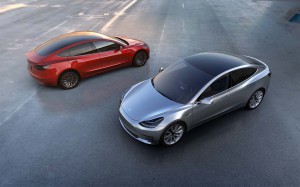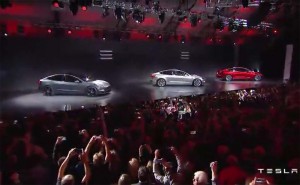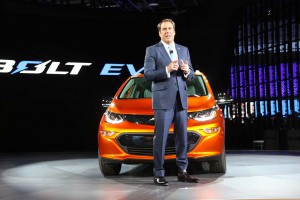Even before the new Model 3 sedan was unveiled late last Thursday, Tesla Motors said it had logged more than 100,000 advanced orders. And as of the following Monday morning, the Silicon Valley carmaker claimed the figure had topped 250,000 – a number that would translate into more than $10 billion in retail sales.
The surge of interest is unprecedented in the auto industry, resembling more the sort of frenzy that has greeted the launch of a new Apple iPhone. But at this early stage, at least 18 months before the first car is scheduled to roll off the assembly line, can the new Tesla Model S be considered a hit, or a case of battery-powered hype?
That’s a question which few industry observers seem to agree upon. Investors have clearly been impressed, driving Tesla’s stock price up by over $15 a share since the hours before the electric sedan’s unveiling. That run-up comes despite the warnings issued by some key analysts.
(For a closer look at the Tesla Model 3, Click Here.)
“I think it’s been over-hyped,” contends Joe Phillippi, a long-time Wall Street investment analyst and current research chief for AutoTrends Consulting. Phillippi stresses that there are a variety of issues that need to be considered before Tesla can claim victory in its bid to transform itself from a low-volume producer of high-priced battery-cars into a high-volume, mainstream manufacturer.
Among other things, Phillippi and other skeptics note, Advance, $1,000 reservations are no guarantee that those customers will actually follow through and purchase the Model 3 when it comes to market. Indeed, it’s far from clear when production will begin, despite Tesla’s goal of getting the Fremont, California plant into gear by late 2017.
The normally confident Tesla founder and CEO Elon Musk himself sounded a note of caution when, last Thursday night, he issued what, for him, was a note of caution, suggesting, “I feel fairly confident (production) will begin next year.” The reality is that Tesla has fallen well behind schedule on all three of the products that came before the Model 3, the most recent one, the Model X SUV, debuting two years later than originally planned.
Musk, meanwhile, promised to double the number of outlets Tesla has by the time the Model 3 goes on sale. But at less than 500 worldwide, it will still leave wide gaps in its presence across the U.S. Its strategy of using only factory-owned showrooms means it will remain locked out of a number of states, for example, and even in those where it can operates, potential buyers may be hours away from a showroom or repair facility.
There is also the reality that even if the Model 3 ultimately does hold to its timetable, it will face a lot more competition. Today, Tesla is the only automaker offering long-range battery-cars. But General Motors will have the 200-mile Chevrolet Bolt in its more than 1,000 U.S. showrooms before the end of this year.
(Better late than never. Click Here for more on the Model X.)
Nissan is reportedly working up a second-generation Leaf that will deliver range closer to that of the Tesla Model 3. And a number of other automakers, including Ford, Audi, Volkswagen and others, are taking aim at the market with more affordable, longer-range offerings.
The vitality of the battery-car market itself could be an issue, analysts like Phillippi warn. Sales of all plug-based models, including both plug-in hybrids and pure battery-electric vehicles like the Model 3 and Bolt, slipped in the U.S. last year and, with gas prices still low, it’s far from certain they’ll regain momentum anytime soon.
Mainstream buyers are quite different from the customers who have supported Tesla until now. Those purchasing the Model S and Model X lines typically have numerous cars in their driveways – and are less likely to be inconvenienced by the serious quality and reliability issues that led Consumer Reports to revoke its “Recommended Buy” rating last year. For many mainstream buyers, the Model 3 will be the only vehicle, and it will need to work every day without fail.
“Supplying all those electric vehicle hopefuls with a reliable, high volume and profitable sedan will require a complete transformation of Tesla’s engineering, production and quality standards,” cautioned Karl Brauer, a senior analyst with Kelley Blue Book.
If the current figure of around 250,000 advance orders does hold, that would be five times Tesla’s total production in 2015. But it would still only come to about half a year’s production when compared to CEO Musk’s goal of using the full capacity of Tesla’s Fremont plant, about 500,000 vehicles annually.
“What happens after they meet the demands of those early adopters?” asks analyst Phillippi.
Despite such concerns, the Tesla reservation bank continues to hum, mystifying skeptics.
“The overwhelming response to the Tesla Model 3 shows that consumers gravitate towards companies, brands, and vehicles that resonate with them, and clearly Tesla does that,” suggests analyst Rebecca Lindland, of KBB.com. “The response is only irrational if we don’t understand what they value. The mystery isn’t in the response. The mystery is in what’s driving the response? That’s the real question that needs an answer.”
(Click Here for a closer look at the Chevrolet Bolt.)





That’s a great picture of the Cruze Hatchback RS. Too bad the caption indicates that its the Chevy Bolt.
Nope, Nick, that’s the Bolt. And here’s a link to our story on the Detroit debut of the Chevy EV where that pic was first used.
http://www.thedetroitbureau.com/2016/01/chevy-offers-a-closer-look-at-bolts-battery-drive/
Paul E.
Bridges is right, and Paul is wrong. You can mislabel the Bolt, all you want, but those pictures are not of the Bolt. The Bolt has a short stubby nose, and looks like an completely different car…
Sure looks a lot like the Cruze hatchback tho…
http://www.chevrolet.com/cruze-hatchback.html
This is the production version of the Bolt:
http://www.autoblog.com/2016/01/11/2017-chevy-bolt-detroit-2016/
Hmmm… 😉
Sigh, I definitely need new glasses. That image was the Cruze hatchback, which shares many basic design features, including lamps and grille. We’ve got a mis-labeled series of images in our image archive which will be corrected.
Thanks for the catch.
Paul A. Eisenstein
Publisher, TheDetroitBureau.com